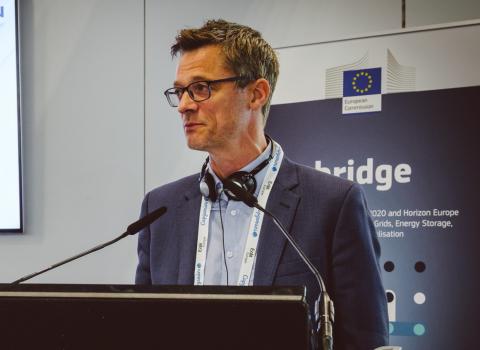The rapid rise of hydraulic fracturing, commonly known as fracking, has become hugely controversial on both sides of the Atlantic. The extraction of shale gas out of rock formations in the U.S. has been accompanied by both intensive use of fresh water and dramatically lowered energy prices. As a result of the environmental damage, environmentalists are up in arms, public opinion in much of Europe is against fracking and France has banned the process.
It didn’t have to be this way, according to Professor Robert H. Socolow, director of the Climate and Energy Challenge at Princeton Environmental Institute. In an interview with Science|Business, Socolow argued that much of the controversy could have been avoided if both the industry and U.S. regulators had been more vigilant. Events in the U.S. may provide a cautionary tale for Europe, which also has substantial shale gas reserves.
“We are flaring natural gas in North Dakota, which is deeply embarrassing,” Socolow said at an academic policy symposium hosted by Science|Business in Brussels last week. ”Flaring (burning off excess gas) is the thing you do when you have a primitive industry...that was a signal to Europe to look closely at fracking.”
Infrastructure to capture and store excess gas should have been installed before drilling started at these wells, Socolow said. In developed countries, flaring is generally rare thanks primarily to rigorous self-regulation by the hydrocarbons industry. “There should have been a sense of propriety,” he added. “Worldwide, the industry has put a lot of effort into policing flaring.”
The European Parliament already has begun to target the shale gas activity. On 9 October it proposed that exploration and hydraulic fracturing extraction activities for non-conventional hydrocarbons be subject to environmental impact studies. In adopting an amendment to existing EU legislation on Wednesday, MEPs also suggest measures to prevent conflicts of interest and to ensure that the public is informed and consulted.
“We are revising this key legislation to align it with Europe's new priorities, such as soils, resource use and protecting biodiversity,” said lead MEP Andrea Zanoni (ALDE). “Hydraulic fracturing raises concerns. We lay down clear criteria to avoid conflicts of interest and involve the public." Zanoni was granted a mandate, by 332 votes to 311, to negotiate a first-reading agreement with EU ministers.
The advent of large-scale fracking actually received a warm welcome from American environmentalists five years ago, according to Socolow, as burning gas in power stations releases far fewer greenhouse gas emissions into the atmosphere than burning coal. Since then the widespread extraction of shale gas has driven down energy prices in the U.S., boosting its manufacturing sector and helping the economy recover from the impact of the financial crisis.
But the shale gas industry has also suffered severe growing pains, making it disruptive and divisive. One of the biggest challenges arises from the abundance of shale gas in parts of the U.S., such as the North East and the Great Plains, that have had little experience with the oil and gas industry, according to Socolow. “In these areas, the shale gas industry has been very poorly policed as they don’t have the regulatory capability at the state level,” said Socolow. “And the industry deterred any attempt at national regulation.”
As well as dramatically expanding the geographic footprint of the hydrocarbon industry, the shale gas boom has also attracted hundreds of small companies that are harder to regulate than the oil majors, according to some industry executives. “Somehow, the gas industry has squandered an opportunity. There was a lot of goodwill from the environmental community in the beginning …but the industry was evasive when asked to disclose chemicals, combative about regulations,” said Socolow.
In the U.S., the shale gas boom has been pursued with a gold-rush mentality in which speed has been paramount, according to some observers. Socolow agrees that “the industry has been in too much of a hurry to go to the next hole. It is all about sequencing – the sequence is the pipe for gas should have gone in before the fracking for oil started.”
However, Socolow believes Europe does not need to make the same mistakes. “Europe may be sufficiently self-conscious to prevent that happening. The industry is closely watched here,” he said.
European countries are generally moving much more cautiously than the U.S. In the Netherlands, for example, the government said in September that it will take another 18 months to study the potential effects of hydraulic fracturing on the environment before allowing the drilling of test wells.
In countries, such as the Netherlands, where there is extensive expertise in hydrocarbons, Socolow is hopeful that fracking can be carried out in a responsible way that balances the economic gains against the environmental impact. “It is just more gas. There should be an expectation that it is going to be done well in the Netherlands, which has a well-established oil and gas industry.” he said. “In the oil patch, it may be done more carefully than elsewhere in the U.S. But the industry was too casual when they moved into new areas. They didn’t look over their shoulders.”




 A unique international forum for public research organisations and companies to connect their external engagement with strategic interests around their R&D system.
A unique international forum for public research organisations and companies to connect their external engagement with strategic interests around their R&D system.